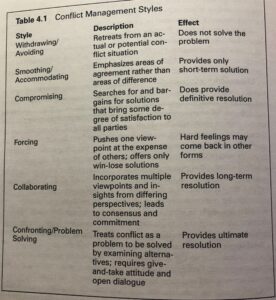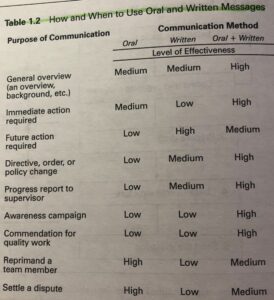In every business, every day isn’t all unicorns and rainbows. Issues and conflicts arise and are inevitable. Why? Behind every business is a group of people. We all have different work styles and habits, personalities, and opinions. And when a group of people get together or work together for any reason, there is bound to be conflict. Furthermore, it is virtually impossible for people to work together, make decisions, delegate, and work towards project goals without conflict. This is just a risk we must accept.
Although this might sound all doom and gloom, it isn’t and doesn’t have to be. There are effective ways to deal with conflict in any business or project environment. In fact, in some cases, conflict can be a good thing (when managed and stimulated appropriately, of course). So, how do you ensure conflict is handled effectively and productively in your organization? Three words: Conflict management model.
In this article, we will discuss the different types of conflict, the value of conflict, and also provide and walk through a step-by-step guide for addressing conflict and implementing an effective conflict management model, allowing your organization to mature from a place of avoiding conflict to embracing conflict.
The Value of Conflict
We all know that there are negative aspects to conflict, and we all know what they are. But what about the positive aspects? As mentioned above, there is value in conflict—healthy conflict, that is.
According to The Human Aspects of Project Management: Human Resource Skills for the Project Manager, Volume II, by Vijay K. Verma, healthy conflict can have the following benefits:
- It diffuses more serious conflicts, which prevents the risk of issues or conflicts from “blowing up” down the road
- It enhances team communication, collaboration, and cohesion
- It can help foster change, which is particularly important for change management
- It increases team productivity and performance
- It helps organizations and project teams achieve a level of power and influence
- It emphasizes problem-solving skills and techniques
- Clarifies issues and goals
Regardless of what we believe or are taught through learned behavior, conflict can be okay (when it’s not destructive, of course). For the reasons mentioned above, embracing conflict is a good idea. It allows mature organizations and project teams to treat conflict as an opportunity for change, creativity, innovation, and challenging the “status quo”.
What Causes Conflict?
So we know that conflict is inevitable, and it can be a good thing, but now let’s address the elephant in the room—what to do when conflict is bad. To do this effectively, we first must understand what causes conflict to begin with and the different types of conflict.
The 3 Common Conflict Categories
Conflict can be broken down into three primary categories:
- Goal-oriented – conflicts associated with end results and performance specifications, criteria, priorities, and objectives.
- Administrative – conflicts refer to the management structure, philosophy, and techniques. Administrative conflicts are primarily based on the definition of responsibilities and authority for tasks, functions, and decisions.
- Interpersonal – conflicts from differences in work ethics, styles, egos, and participants’ personalities and individual perceptions and opinions
To break these categories down a step further, here are the four different types of conflict that arise between individuals and groups:
- Intrapersonal conflict – Role conflict, stems from unmet personal or professional expectations within individuals.
- Interpersonal conflict – Conflicts that occur between specific team members or between one person and the entire group. Interpersonal conflicts often arise due to differences in personality, style, communication skills, or competing personal ambitions. is most often caused by
- Intragroup conflict – A conflict between a single person and a group of people (such as his or her project team).
- Intergroup conflict – A conflict that arises between groups of people within a project team, or cross-functionally.
There are thousands of scenarios and reasons for why any of the above three types of conflicts can occur—far too many to list in this article. However, one common cause of conflict—and one I have recently encountered personally—is a particular project phase.
Conflicts Arise and Fall with Project Phases
Different conflict types and intensities can arise depending on a particular project phase. For example, conflict intensity at the beginning of a project tends to be lower. If a conflict does arise, then it tends to occur over cost, talent resources, and differing personalities as the team is assembled and learns how to work together. On the other hand, during the final project phases, conflict intensity tends to increase and occurs over the project schedule. This is because the team is stressed and anxious about pushing through the final phase.
Here are some recent, real-life examples I personally encountered while working with clients and project teams:
Conflict Management: Project #1 – Change
After months of brainstorming solutions to a data hygiene and transformation problem, I worked with two key stakeholders to help narrow down and decide on four relatively low-effort but high-impact solutions to implement. Although implementing the solutions had a high success rate, they still involved change. As part of our project communications plan, I crafted and sent an email to the entire core project team and broader stakeholder group, letting them know what decisions we had made, what solutions would be implemented, and the next steps we would take to move forward.
Although no one replied to my email directly, it created tension and conflict “behind the scenes”. This was brought to my attention during one of our weekly status check meetings with the team, when one particular team member used some “choice” words in response to the team addressing the next steps for implementing one of the solutions. The team member’s comment then sparked a small argument with the project owner, which I quickly had to do my best to corral. After the meeting, I reached out to both team members individually to hear their perspectives and opinions better to understand the “why” behind the conflict.
My next step was to schedule a group meeting to help resolve the conflict. However, the two individuals met independently and worked through it together. This particular conflict wasn’t necessarily interpersonal but related to the change itself. In many cases, and just like this one, conflict arises due to varying stages of team development. This shows that this particular team has reached a level of development where they can work through and resolve issues and conflicts on their own in a healthy manner.
Conflict Management: Project #2 – “Crunch Time”
We were reaching the final 30 days of the project; therefore, conflict and tensions were high, particularly around schedule. In an effort to help manage this conflict, I offered to step in and help the team with some of the final QA checks to help get the project ready to launch. I realize this is beyond my typical “project management scope”, but it is more important for me to see the project and the team succeed. I also offered to help corral other resources to help push the final QA phase along and prepare them for launch, which the team graciously accepted. After developing a solid QA plan for launch, stress levels decreased slightly.
This is an example of how I used “soft” conflict “smoothing” techniques to not resolve the conflict entirely, but help reduce stress levels by reinforcing that the team has resources to help them and they don’t have to go about it alone.
How to Implement a Conflict Management Model
Now that you understand more about the different types of conflict and what causes them, what is a good conflict management model to implement in your organization, and how do you implement one? Conflict can be resolved and controlled by taking a proactive approach to managing conflict.
When thinking about how to implement a conflict management model, here are some steps to follow:
1. Assess your organization’s current conflict view.
The first step is to assess how your organization currently views conflict. Here are the three common conflict views:
- Traditional – conflict is bad and always harms organizations
- Behavioral or contemporary – accepts that conflict is natural and inevitable
- Interactionist – conflict is necessary to increase performance
After assessing how your organization currently views and handles conflict, you can then begin to determine the best approach to conflict, develop and implement a model, and push your organization to change and mature.
2. Assess your conflict management strategy and style.
The second step is to look at your current team members and project leaders, and understand how conflict is handled today. For example, are team members and leaders smoothing and accommodating? Or do they withdraw at the first sign of conflict? Refer to the chart below for guidance:
Source: The Human Aspects of Project Management: Human Resource Skills for the Project Manager, Volume II, by Vijay K. Verma
Unresolved conflicts tend to build up and create an even more tense atmosphere, which can, in turn, lead to more intense and destructive conflicts. Even if a conflict appears trivial to a leader, it can blow up down the road.
3. Determine the best conflict resolution approach.
If I told you that choosing the best conflict management approach was easy, that would be a lie. So, how do you know which conflict management approach you should implement? It honestly depends on the individuals involved and the situation. Each situation is unique, the players involved have differing personalities, and the dynamic nature of every conflict is just different.
Choosing the best conflict resolution approach depends on the following:
- Type of conflict
- Time pressure
- Positions of players involved
- Relative emphasis on goals and relationships
Step 1: Define the problem.
Effective conflict management requires a combination of human skills. The first step in managing conflict is to understand and correctly diagnose it. Acknowledge and agree that conflict exists. Establish those common ground rules. Separate problems from people, emotions from facts.
If the conflict has caused an incredibly tense and potentially damaging situation, then your first order of business is to diffuse those heightened emotions.
Step 2: Explore and evaluate alternatives.
Ask each team member or stakeholder involved in the conflict to write down or list possible solutions and alternatives to solving the problem. These alternatives should be analyzed and ranked following clear objectives and fair criteria rather than opinions, perceptions, biases, and attitudes. This takes a “trade-off” approach to resolving the conflict, and aiming for a win-win strategy, or pretty close to one. The goal of this step is to look for areas where you and the other party or parties agree.
Step 3: Select the best alternative.
After conducting a proper analysis, select the best alternative, and prepare proper communication to the team and stakeholder group. What is the best way to communicate an alternative to resolving a conflict? Refer to your communications plan. Here is an excellent example:
Step 4: Handle the conflict.
Finally, have a plan for how to handle the conflict. To do this effectively, you first must assess the following:
- Cooperativeness dimension – represents the degree to which the person wants to satisfy the concerns of the other party
- Assertiveness dimension – represents the degree to which the other person wants to satisfy his or her point of view or concerns.
Communication is most often the primary culprit behind conflict. However, if you dive a bit deeper, what is the other hidden culprit? CHANGE. In fact, projects with excellent change management were SIX times more likely to meet objectives than those with poor change management.
You can also build an “issue log”. Issue logs are primarily used for quality management purposes, but you can build one to help track the different types of conflicts and issues that arise.
Sometimes, you may need to negotiate to reach a resolution. In another article, I dive into the different negotiation tactics and process for using negotiation as part of a conflict management model.
Final Conflict Management Tips and Takeaways
Conflict management can be tricky to implement. As explained above, the best approach to conflict management highly depends on team development, team dynamics, and the causes and sources of conflict. The first step to understanding, handling, and resolving any conflict is understanding the real WHY behind it. All in all, a good conflict management model involves the following:
- Analyzing and understanding how and why a conflict occurred (instilling proper diagnostics) and diagnosing conflict correctly
- Displaying a solutions-focused attitude
- Avoiding finger-pointing and playing “the blame game”
- Selecting a particular interpersonal style and communication processes
- The different types of conflict that frequently occur
- The impact of conflicts on performance and productivity
- Developing trust and respect
- Creating a culture of collaboration
- Negotiation
- Identify win-win scenarios
- Building structural interventions to avoid unnecessary conflict and reduce or resolve excessive conflict. These can include procedures, personnel, authority structures, and reporting relationships
In some cases, it may be appropriate to stimulate conflict, depending on the situation. If an organization must reach its next maturity phase, then part of the transformation process should involve challenging and questioning “the status quo”. One way to do this is by stimulating conflict—carefully, of course. You can do this by introducing new or outside team members or consultants who might have a fresh, outside perspective to bring to the table and help the team think and work differently.
As a professional, I understand, recognize, and respect the value of conflict. Over the years, I have perfected my conflict management approach, realizing that not every conflict is productive. In fact, the negative impacts of conflict are more prevalent than the positive impacts. Throughout my career, emotional intelligence and even taking a “coaching” approach to working with people, understanding the source or root cause of an issue, and helping to solve the issue have served me well time and time again through conflict resolution. By allowing project team members to feel “heard” and by focusing on successful project outcomes, conflict can be positive and healthy for growing teams.
Finally, implementing a conflict management model is key to growing and scaling any organization.
Need some advice on how to best resolve conflict or develop a conflict management model or change management model in your organization? Let’s chat. I’d love to learn more about your business, your challenges, and help you to solve them.




